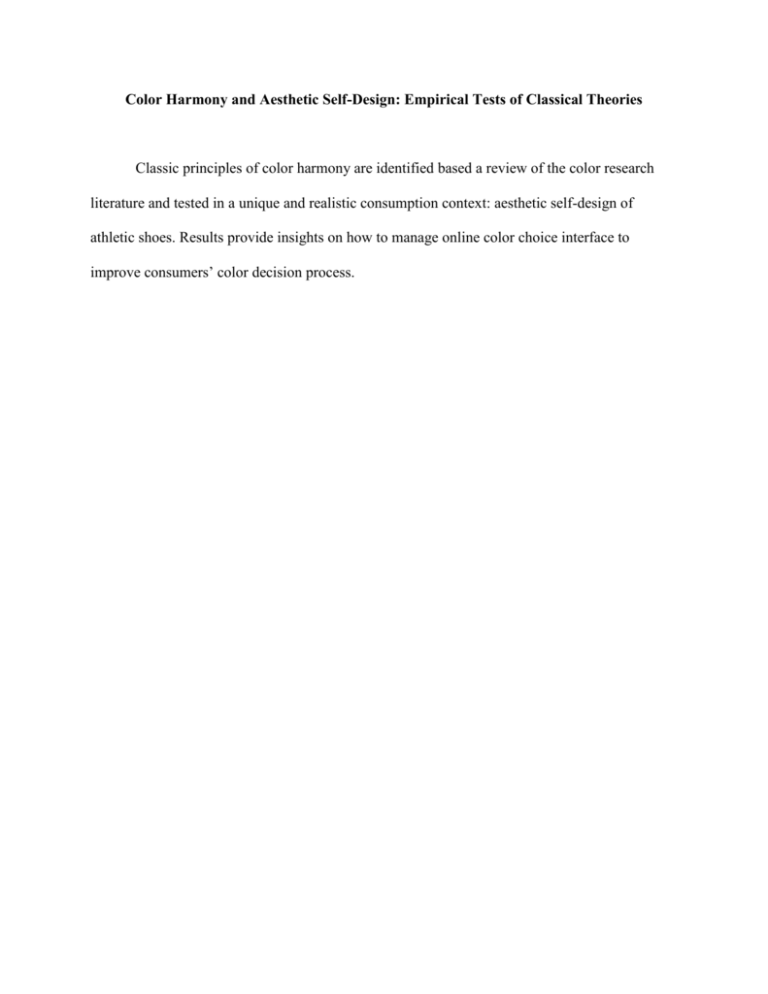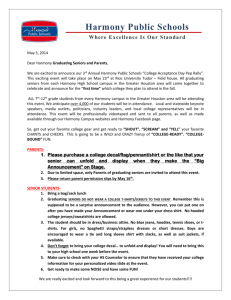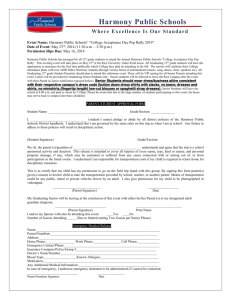Color Harmony and Aesthetic Self
advertisement

Color Harmony and Aesthetic Self-Design: Empirical Tests of Classical Theories Classic principles of color harmony are identified based a review of the color research literature and tested in a unique and realistic consumption context: aesthetic self-design of athletic shoes. Results provide insights on how to manage online color choice interface to improve consumers’ color decision process. In this paper, we aimed at identifying and testing principles that can explain and predict color harmony perception. Color harmony is a function of distance between colors in the color space. We first briefly described different models of color space and reviewed the color harmony literature, based on which we summarized three classic principles of color harmony (i.e., identity, similarity, and contrast) that were relatively well-accepted in this literature. Because the coordinate system underlying the classic color solids does not provide a straightforward distance metric to represent color similarity or difference (i.e., do not satisfy perceptual uniformity), we adopted the theoretical background of a more recent, alternative coordinate system (i.e., CIELAB coordinate system), which was designed to approximate human vision thereby provides a straightforward distance metric for color perception. We then reviewed prior empirical tests of classic color harmony theories that are similar to the principles we summarized. Some of these tests were conducted using the classic cylindrical coordinate system, others using the modern CIELAB color space. Nevertheless we found that these tests generate mixed results. For our own test of the color harmony principles we adopted a unique and realistic context: aesthetic self-design of an athletic shoe (which has seven areas: base, secondary, swoosh, accent, lace, lining, and shox). This specific type of self-design task is especially suitable for testing color harmony principles because, first, the task environment allows for interactive color harmony judgment and, second, color harmony plays a major role in consumers’ decision. Based on this context, we proposed hypotheses about the relationships between the observed frequencies of color combinations in self-designed athletic shoes and color distance for identity, similarity, and contrast. Further, we hypothesized that a “small palette” can meet the need for color harmony if it is indeed determined by identity (if a single color is used repeatedly then less colors are needed in the palette) or contrast (colors that are mutually complementary spread evenly in the color space and the number of such colors is limited). Results from our empirical tests provide evidence for our hypotheses. First, the principle of identity was supported for color pairs involving minor shoe areas (e.g., swoosh, lace, lining, and shox). Second, the principle of similarity was supported for the two major shoe areas (i.e., base and secondary). Third, the principle of contrast was supported for color pairs involving a major and a minor shoe area (e.g., base-lining, base-shox). Finally, the “small palette” hypothesis was also supported as the number of colors actually used in self-designed athletic shoes was smaller than the number expected based on assumption of statistical independence. Taking these results together, we can picture the color coordination strategy consumers use during the self-design process, in which they make seven sequential color decisions for base, secondary, swoosh, accent, lace, lining, and shox (ordered as such). First, they pick a color for base according to their own preference. Second, anchoring on the base color, they choose a secondary color that is similar to that of base. Third, when making color decisions for the remaining five minor areas, consumers tend to use the same color for most of these areas, and this color oftentimes is a color contrasting to the base color. Taking into account the relative area of the seven shoe components, this strategy leads to a harmonious design where large areas define the overall color scheme of the shoe while small areas deviate from the basic scheme and “spice up” the overall design. This shows that when coordinating multiple colors, consumers are guided by intuitions about color harmony and their intuitions are consistent with the principles of identity, similarity, and contrast. The identification and confirmation of several robust principles of color harmony provide some practical insights for managers of aesthetic self-design programs. First, these well-defined principles can be used as guidelines to design the color palettes. Second, the number of colors included in the color palettes can be greatly reduced therefore the size of the solution space of the self-design configurator can be largely reduced as well. Third, based on color harmony principles, the configurator can be designed to generate automatic recommendations to the user regarding her color choice. Last but not least, although in this paper we implicitly assume that most people prefer color harmony, those who are fond of disharmonious color combinations can also benefit from our research findings. Online product configurators include a simple survey about personal color taste to categorize their customers and, for some of them, provide “clashing” color palettes.






